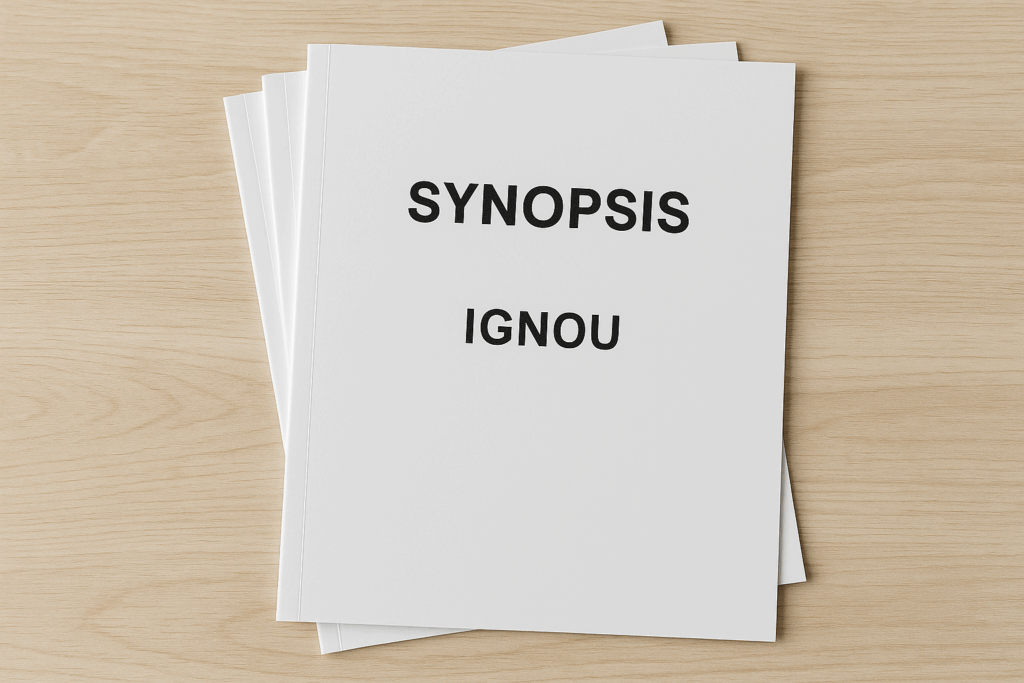If you’re pursuing your Master of Commerce from IGNOU, one of the most important academic milestones you’ll face is the project work. Before you can begin writing your full project report, there’s a mandatory step that often causes stress among students, the synopsis. The synopsis isn’t just a formality. It’s the base on which your entire project stands. Without a properly structured and approved synopsis, your final report won’t even be accepted.
This article will walk you through the essentials of preparing a well-organized IGNOU MCom synopsis and help you avoid the common traps students fall into.
What Is an IGNOU MCom Synopsis?
Think of your synopsis as a mini version of your project. It outlines what you’re planning to research, how you’ll do it, and why it matters. IGNOU uses it to assess the feasibility and relevance of your proposed study before giving you the green light.
The synopsis is submitted for approval to your Regional Centre, and you need a faculty-approved Project Guide to sign off on it.
Structure of the IGNOU MCom Synopsis
IGNOU doesn’t provide a rigid template, but most approved synopses follow a fairly consistent structure. Here’s a clean format to help you write one that stands up to academic scrutiny:
1. Title of the Project
Make this short and specific. Avoid vague phrases. For instance:
- A Study on Working Capital Management in Indian FMCG Companies
2. Introduction
This is the opening section where you briefly introduce the theme. Set the context. Why is this area worth exploring? Keep it focused and informative. Avoid unnecessary theory.
Example:
The FMCG sector in India is a highly competitive space where working capital decisions significantly impact performance. This study will focus on evaluating the strategies used by selected companies to manage their short-term finances effectively.
3. Need for the Study
Explain what gap your study aims to fill. This shows your understanding of the subject and justifies your interest in the topic.
Example:
Despite the importance of liquidity in FMCG firms, very few studies have looked at the working capital practices of medium-sized players. This project aims to explore that.
4. Objectives of the Study
List 3–5 key objectives. These are your research goals.
Examples:
-
To analyze the working capital trends in selected FMCG firms.
-
To evaluate the impact of working capital on profitability.
-
To suggest improvements based on findings.
Write each one clearly and make sure they align with your topic.
5. Hypothesis (if applicable)
This is optional but useful if you’re doing a quantitative study. A hypothesis is a statement you’ll test during your research.
Example:
There is no significant relationship between working capital and net profit in FMCG companies.
6. Research Methodology
This part is crucial and often the reason why many synopses get rejected. It tells IGNOU how you plan to carry out the study.
Include:
-
Type of data (primary, secondary, or both)
-
Sources (company websites, annual reports, surveys, etc.)
-
Sampling method
-
Size of the sample
-
Tools for analysis (ratio analysis, trend analysis, etc.)
7. Scope of the Study
Mention the boundaries of your research—what it will cover and what it will not.
Example:
The study will focus on three mid-sized FMCG companies in India over the last five financial years. It will not include start-ups or unlisted firms.
8. Limitations
No study is perfect. Listing limitations doesn’t weaken your project—it adds credibility. Mention things like limited access to data or small sample size.
9. Expected Outcome
Based on your objectives, state what kind of results you’re expecting. This shows you’ve thought through the implications.
10. References
Always include at least 3–5 references in proper format. Use books, research journals, and verified online sources. Avoid random blog links or AI-generated material.
Sample IGNOU MCom Synopsis PDF [Download Link]
To make things easier, we’ve prepared a sample synopsis in PDF format based on the format above.
Download IGNOU MCom Synopsis Sample PDF
You can use this sample as a guide while writing your own. But avoid copying it word-for-word. Your project must reflect your original thinking and effort.
Common Mistakes Students Make in the Synopsis
Avoid these mistakes to improve your chances of approval on the first try:
-
Submitting vague or overly broad topics.
-
Writing only theory with no clear plan of data collection.
-
Listing generic objectives that don’t match the title.
-
Forgetting to get your guide’s signature.
-
Ignoring regional centre-specific rules.
How to Submit the Synopsis
Follow these steps:
-
Prepare the synopsis in a soft copy (MS Word or PDF).
-
Print and attach the signed Project Proposal Form (available from IGNOU’s official website).
-
Attach your guide’s biodata (especially if not from IGNOU).
-
Submit to your Regional Centre by hand or post (some centres also accept email—confirm with yours).
What to Do After Submission?
You’ll receive approval or feedback (usually within 30–45 days). If accepted, you’re clear to start your project. If rejected, you’ll be asked to make changes and resubmit.
Check your email and keep in touch with your regional centre for status updates.
Final Note
Preparing a synopsis doesn’t require extraordinary writing skills. What it needs is clarity, a focused idea, and a realistic plan of execution. A well-written synopsis makes the rest of your project journey much smoother.

